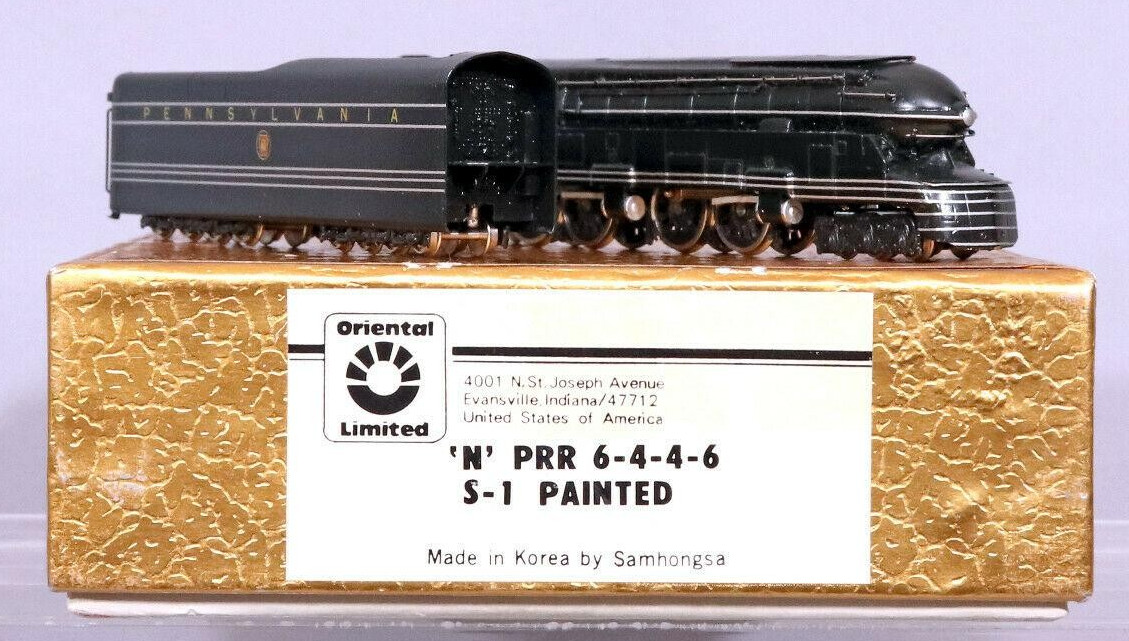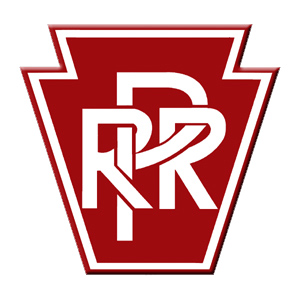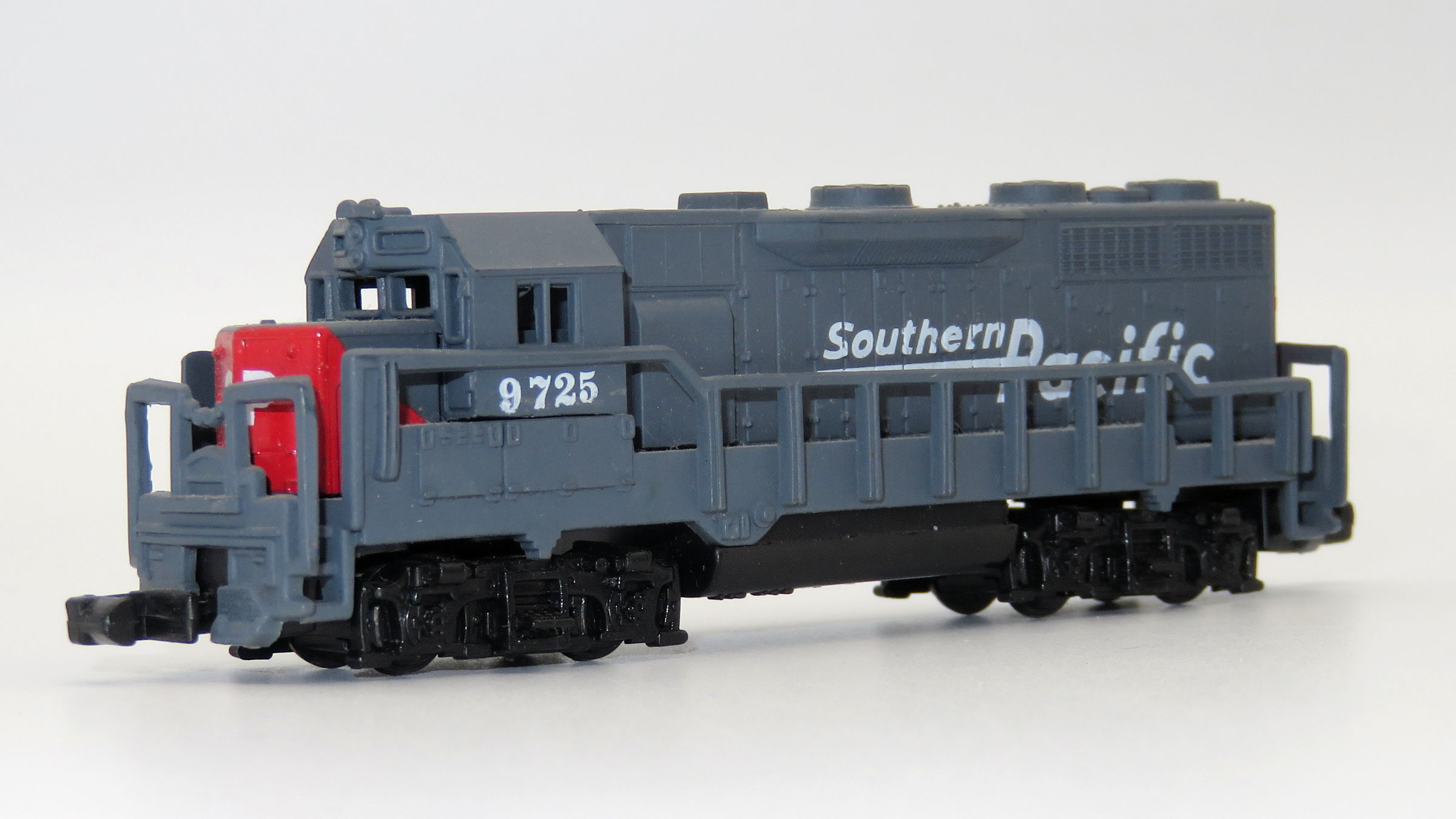Oriental Limited - PRR S-1 Painted - Locomotive, Steam, 6-4-4-6 S1 - Pennsylvania - 6100
| Stock Number | PRR S-1 Painted |
| Original Retail Price | $345.00 |
| Brand | Oriental Limited |
| Manufacturer | Samhongsa |
| Body Style | Samhongsa Steam Engine 6-4-4-6 |
| Prototype Vehicle | Locomotive, Steam, 6-4-4-6 S1 (Details) |
| Road or Company Name | Pennsylvania (Details) |
| Road or Reporting Number | 6100 |
| Paint Color(s) | Brunswick Green w/White Striping and Red Keystone |
| Print Color(s) | Gold |
| Wheel Type | Nickel-Silver Plated Metal |
| Wheel Profile | Small Flange (Low Profile) |
| Release Date | 1986-01-01 |
| Item Category | Locomotives |
| Model Type | Steam |
| Model Subtype | 6-4-4-6 |
| Model Variety | S1 |
| Prototype Region | North America |
| Prototype Era | NA Era III: Transition (1939 - 1957) |
| Years Produced | 1939 |
| Scale | 1/160 |
Specific Item Information:
This is a fine running all-brass model, but like the prototype, favors broad radius curves.
Prototype History:
A 6-4-4-6 steam locomotive, in the Whyte notation for describing locomotive wheel arrangements, is one with six leading wheels, two sets of four driving wheels, and six trailing wheels.
Only one was produced, the Pennsylvania Railroad's sole class S1 of 1939. It was a duplex locomotive, the longest and heaviest rigid frame reciprocating steam locomotive ever built, and is referred to as the Pennsylvania Type. This experimental locomotive was exhibited at the 1939 New York World's Fair, and was afterward placed in limited service between Chicago, Illinois, and Crestline, Ohio. The locomotive was too large to work elsewhere in the system. Pennsylvania Railroad executives hoped that the locomotive could haul 1,000 tons at 100 miles per hour, but this goal was not reached. It was capable of very high speeds however, although no documentary evidence has so far surfaced to add credence to stories of record-breaking performance.
Only one was produced, the Pennsylvania Railroad's sole class S1 of 1939. It was a duplex locomotive, the longest and heaviest rigid frame reciprocating steam locomotive ever built, and is referred to as the Pennsylvania Type. This experimental locomotive was exhibited at the 1939 New York World's Fair, and was afterward placed in limited service between Chicago, Illinois, and Crestline, Ohio. The locomotive was too large to work elsewhere in the system. Pennsylvania Railroad executives hoped that the locomotive could haul 1,000 tons at 100 miles per hour, but this goal was not reached. It was capable of very high speeds however, although no documentary evidence has so far surfaced to add credence to stories of record-breaking performance.
Road Name History:
The Pennsylvania Railroad (reporting mark PRR) was an American Class I railroad, founded in 1846. Commonly referred to as the "Pennsy," the PRR was headquartered in Philadelphia, Pennsylvania.
The PRR was the largest railroad by traffic and revenue in the U.S. for the first half of the twentieth century. Over the years, it acquired, merged with or owned part of at least 800 other rail lines and companies. At the end of 1925, it operated 10,515 miles of rail line; in the 1920s, it carried nearly three times the traffic as other railroads of comparable length, such as the Union Pacific or Atchison, Topeka & Santa Fe railroads. Its only formidable rival was the New York Central (NYC), which carried around three-quarters of PRR's ton-miles.
At one time, the PRR was the largest publicly traded corporation in the world, with a budget larger than that of the U.S. government and a workforce of about 250,000 people. The corporation still holds the record for the longest continuous dividend history: it paid out annual dividends to shareholders for more than 100 years in a row.
In 1968, PRR merged with rival NYC to form the Penn Central Transportation Company, which filed for bankruptcy within two years. The viable parts were transferred in 1976 to Conrail, which was itself broken up in 1999, with 58 percent of the system going to the Norfolk Southern Railway (NS), including nearly all of the former PRR. Amtrak received the electrified segment east of Harrisburg.
The PRR was the largest railroad by traffic and revenue in the U.S. for the first half of the twentieth century. Over the years, it acquired, merged with or owned part of at least 800 other rail lines and companies. At the end of 1925, it operated 10,515 miles of rail line; in the 1920s, it carried nearly three times the traffic as other railroads of comparable length, such as the Union Pacific or Atchison, Topeka & Santa Fe railroads. Its only formidable rival was the New York Central (NYC), which carried around three-quarters of PRR's ton-miles.
At one time, the PRR was the largest publicly traded corporation in the world, with a budget larger than that of the U.S. government and a workforce of about 250,000 people. The corporation still holds the record for the longest continuous dividend history: it paid out annual dividends to shareholders for more than 100 years in a row.
In 1968, PRR merged with rival NYC to form the Penn Central Transportation Company, which filed for bankruptcy within two years. The viable parts were transferred in 1976 to Conrail, which was itself broken up in 1999, with 58 percent of the system going to the Norfolk Southern Railway (NS), including nearly all of the former PRR. Amtrak received the electrified segment east of Harrisburg.
Manufacturer Information:
Samhongsa was a Korean manufacturer of model trains, well know for its brass models, imported notably by Hallmark Models. The company ceased its activity in the early 2000s. Some of the employees continued the brass model business as Sam Model Tech.
Item created by: RoadRailer
on 2017-02-11 19:54:41
Last edited by: gdm on 2020-11-13 07:29:58
If you see errors or missing data in this entry, please feel free to log in and edit it. Anyone with a Gmail account can log in instantly.
Last edited by: gdm on 2020-11-13 07:29:58
If you see errors or missing data in this entry, please feel free to log in and edit it. Anyone with a Gmail account can log in instantly.










